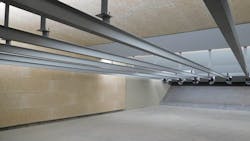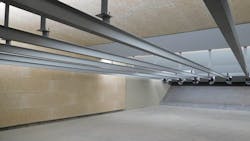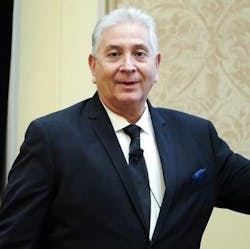The Business of Noise: Managing Sound Inside, Outside Gun Ranges
When designing a new shooting range or upgrading an existing one, noise levels always have to be taken into account. Managing the noise inside, and outside, of the range will allow the law enforcement agency to stay compliant with OSHA noise exposure limits and local noise ordinances, improve its “good neighbor” image within the community and keep its officers safe.
Bill Bergiadis, President and CEO of Troy Acoustics, spoke at the 2022 Station Design Conference in Rosemont, Illinois about the basics of range acoustics, the full-body dangers of repeated gunfire audibility and the various materials and designs needed for effective noise mitigation in a law enforcement setting.
He talked about what is known as the blast overpressure. “Similar to an IED when it goes off 50 feet, 60 feet in front of you, you don’t have any shrapnel, yet this guy drops down and he’s dead, but there’s no evidence of shrapnel there. It’s that blast overpressure,” he says, adding that even when an officer is wearing hearing protection, they are exposed to blast overpressure.
“Hearing protection protects the ears, but what about the rest of your body? We found that the best way to solve that problem is to treat the range.”
Another issue, according to Bergiadis, is limiting the noise from the range that can be heard outside of the range. “A lot of times your gunfire will travel out and be intrusive to the neighbors,” he says, citing a case where the Clearwater Police Department ended up on the 5 o’clock news after receiving noise complaints from its range. “Outside the range—if it’s an outdoor range or an indoor range—that gunfire is going to travel and be intrusive to your neighbors. That becomes a problem that can become a legal mater and you don’t want to get into that arena.”
He says that when treating a shooting range, agencies must get rid of the time that maximum level gunfire is in the range. “That’s the whole intend of an acoustically treated range. You don’t want that gunfire sound level to last long in the range because it creates an OSHA violation on the hearing exposure to the shooters and instructors. If you take away the time the gunfire lasts in the range, then you are doing really well.”According to Bergiadis, Portalnd Cement Wood fiber board is one of the best materials to use to absorb sound inside a shooting range as it possesses a zero flame spread and zero smoke developed fire rate. The cement wood fiber boards also can be patched. Just as in any other range, they can be cleaned via the HEPA vacuum.
“You are also reducing that pressure on the body so it makes it safer for the guys who are in the range and train a lot longer,” he says. “The blast overpressure affects your body and your brain. Unless you have Kevlar around your head, and tight fitting over your ears, your brain and your body are exposed to that blast overpressure.”
About the Author
Paul Peluso
Editor
Paul Peluso is the Managing Editor of OFFICER Magazine and has been with the Officer Media Group since 2006. He began as an Associate Editor, writing and editing content for Officer.com. Previously, Paul worked as a reporter for several newspapers in the suburbs of Baltimore, MD.




